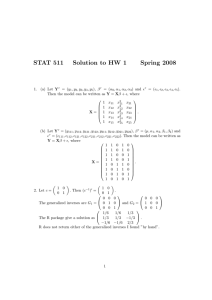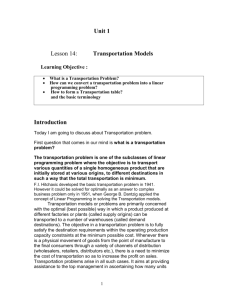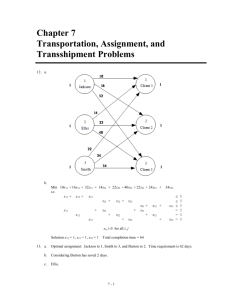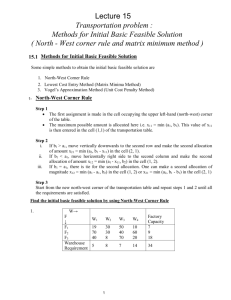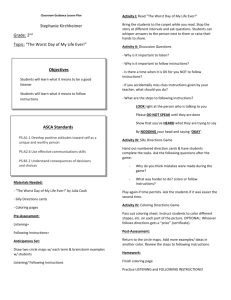Cases where finding the minimum entropy coloring of a
advertisement
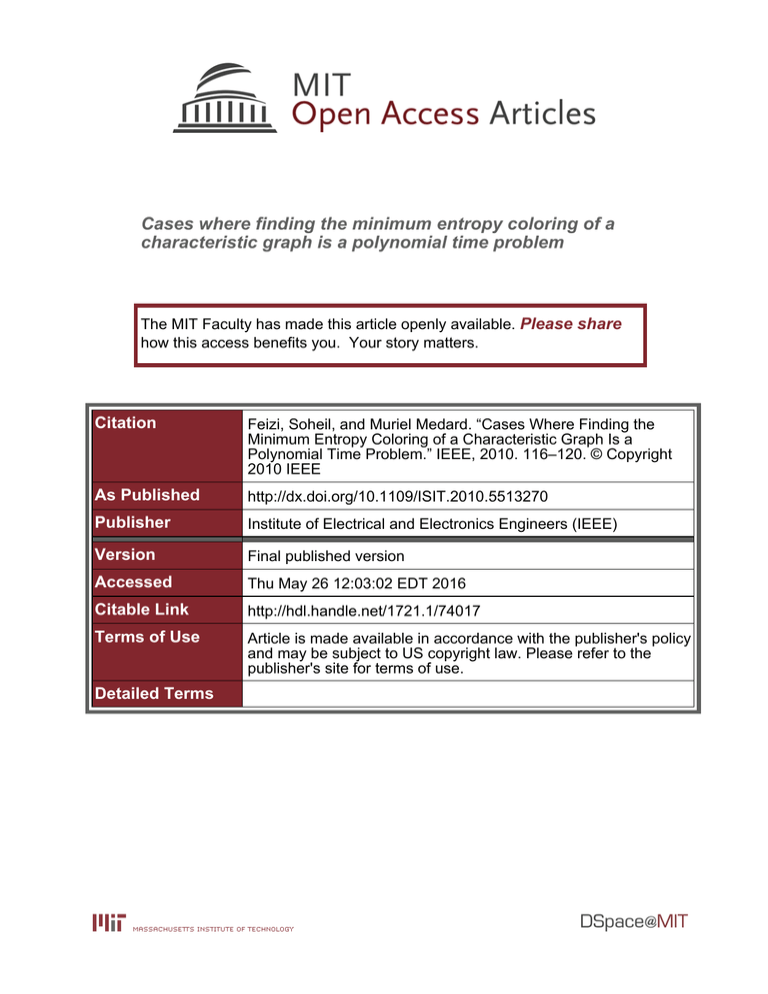
Cases where finding the minimum entropy coloring of a
characteristic graph is a polynomial time problem
The MIT Faculty has made this article openly available. Please share
how this access benefits you. Your story matters.
Citation
Feizi, Soheil, and Muriel Medard. “Cases Where Finding the
Minimum Entropy Coloring of a Characteristic Graph Is a
Polynomial Time Problem.” IEEE, 2010. 116–120. © Copyright
2010 IEEE
As Published
http://dx.doi.org/10.1109/ISIT.2010.5513270
Publisher
Institute of Electrical and Electronics Engineers (IEEE)
Version
Final published version
Accessed
Thu May 26 12:03:02 EDT 2016
Citable Link
http://hdl.handle.net/1721.1/74017
Terms of Use
Article is made available in accordance with the publisher's policy
and may be subject to US copyright law. Please refer to the
publisher's site for terms of use.
Detailed Terms
ISIT 2010, Austin, Texas, U.S.A., June 13 - 18, 2010
Cases Where Finding the Minimum Entropy
Coloring of a Characteristic Graph is a Polynomial
Time Problem
Soheil Feizi, Muriel Médard
RLE at MIT
Emails: {sfeizi,medard}@mit.edu
Abstract—In this paper, we consider the problem of finding
the minimum entropy coloring of a characteristic graph under
some conditions which allow it to be in polynomial time. This
problem arises in the functional compression problem where the
computation of a function of sources is desired at the receiver.
The rate region of the functional compression problem has been
considered in some references under some assumptions. Recently,
Feizi et al. computed this rate region for a general one-stage tree
network and its extension to a general tree network. In their
proposed coding scheme, one needs to compute the minimum
entropy coloring (a coloring random variable which minimizes
the entropy) of a characteristic graph. In general, finding this
coloring is an NP-hard problem (as shown by Cardinal et
al.) . However, in this paper, we show that depending on the
characteristic graph’s structure, there are some interesting cases
where finding the minimum entropy coloring is not NP-hard,
but tractable and practical. In one of these cases, we show
that, having a non-zero joint probability condition on RVs’
distributions, for any desired function f , makes characteristic
graphs to be formed of some non-overlapping fully-connected
maximal independent sets. Therefore, the minimum entropy
coloring can be solved in polynomial time. In another case, we
show that if f is a quantization function, this problem is also
tractable.
which minimizes the entropy) of a characteristic graph. In
general, finding this coloring is an NP-hard problem ([6]).
However, in this paper, we show that depending on the characteristic graph’s structure, there are certain cases where finding
the minimum entropy coloring is not NP-hard, but tractable
and practical. In one of these cases, we show that, having
a non-zero joint probability condition on RVs’ distributions,
for any desired function f , makes characteristic graphs to
be formed of some non-overlapping fully-connected maximal
independent sets. Then, the minimum entropy coloring can be
solved in polynomial time. In another case, we show that if f
is a quantization function, this problem is also tractable.
The rest of the paper is organized as follows. Section II
presents the minimum entropy coloring problem statement and
the necessary technical background. In Section III, main results of this paper are expressed. An application of this paper’s
results in the functional compression problem is explained in
Section IV. We conclude the paper in Section V.
Index Terms—Functional compression, graph coloring, graph
entropy.
In this section, after expressing necessary definitions, we
formulate the minimum entropy coloring problem.
We start with the definition of a characteristic graph of
a random variable. Consider the network shown in Figure
1 with two sources with RVs X1 and X2 such that the
computation of a function (f (X1 , X2 )) is desired at the
receiver. Suppose these sources are drawn from finite sets
|X |
|X |
X1 = {x11 , x21 , ..., x1 1 } and X2 = {x12 , x22 , ..., x2 2 }. These
sources have a joint probability distribution p(x1 , xk ). We
express n-sequences of these RVs as X1 = {X1i }i=l+n−1
i=l
and X2 = {X2i }i=l+n−1
with the joint probability distribution
i=l
p(x1 , x2 ). Without loss of generality, we assume l = 1, and
to simplify notation, n will be implied by the context if no
confusion arises. We refer to the ith element of xj as xji . We
use x1j , x2j ,... as different n-sequences of Xj . We shall drop
the superscript when no confusion arises. Since the sequence
(x1 , x2 ) is drawn
n i.i.d. according to p(x1 , x2 ), one can write
p(x1 , x2 ) = i=1 p(x1i , x2i ).
I. I NTRODUCTION
While data compression considers the compression of
sources at transmitters and their reconstruction at receivers,
functional compression does not consider the recovery of
whole sources, but the computation of a function of sources
at the receiver(s).
This problem has been considered in different references
(e.g., [1], [2], [3], [4]). In a recent work in [5], we showed
that, for any one-stage tree network, if source nodes send colorings of their characteristic graphs satisfying a condition
called the Coloring Connectivity Condition (C.C.C.), followed
by a Slepian-Wolf encoder, it will lead to an achievable coding
scheme. Conversely, any achievable scheme induces colorings
on high probability subgraphs of characteristic graphs satisfying C.C.C. An extension to a tree network is also considered
in [5].
In the proposed coding scheme in [5], we need to compute
the minimum entropy coloring (a coloring random variable
This work was supported by AFOSR award number FA9550-09-1-0196.
978-1-4244-7892-7/10/$26.00 ©2010 IEEE
116
II. P ROBLEM S ETUP
Definition 1. The characteristic graph GX1 = (VX1 , EX1 ) of
X1 with respect to X2 , p(x1 , x2 ), and function f (X1 , X2 ) is
defined as follows: VX1 = X1 and an edge (x11 , x21 ) ∈ X12 is in
EX1 iff there exists a x12 ∈ X2 such that p(x11 , x12 )p(x21 , x12 ) >
0 and f (x11 , x12 ) = f (x21 , x12 ).
ISIT 2010
ISIT 2010, Austin, Texas, U.S.A., June 13 - 18, 2010
w2
w1
X1
X2
x13
x12
Fig. 1. A network with two sources where the computation of a function is
desired at the receiver.
In other words, in order to avoid confusion about the
function f (X1 , X2 ) at the receiver, if (x11 , x21 ) ∈ EX1 , then
descriptions of x11 and x21 must be different.
Next, we define a coloring function for a characteristic
graph.
Definition 2. A vertex coloring of a graph is a function
cGX1 (X1 ) : VX1 →
of a graph GX1 = (VX1 , EX1 ) such
that (x11 , x21 ) ∈ EX1 implies cGX1 (x11 ) = cGX1 (x21 ). The
entropy of a coloring is the entropy of the induced distribution
i
on colors. Here, p(cGX1 (xi1 )) = p(c−1
GX1 (cGX1 (x1 ))), where
j
j
i
i
c−1
GX1 (x1 ) = {x1 : cGX1 (x1 ) = cGX1 (x1 )} for all valid j is
called a color class. We also call the set of all valid colorings
of a graph GX1 as CGX1 .
N
Sometimes one needs to consider sequences of a RV with
length n. In order to deal with these cases, we can extend the
definition of a characteristic graph for vectors of a RV.
Definition 3. The n-th power of a graph GX1 is a graph
n
n
GnX1 = (VXn1 , EX
) such that VXn1 = X1n and (x11 , x21 ) ∈ EX
1
1
1
2
when there exists at least one i such that (x1i , x1i ) ∈ EX1 .
We denote a valid coloring of GnX1 by cGnX (X1 ).
1
In some problems such as the functional compression problem, we need to find a coloring random variable of a characteristic graph which minimizes the entropy. The problem is how
to compute such a coloring for a given characteristic graph.
In other words, this problem can be expressed as follows.
Given a characteristic graph GX1 (or, its n-th power, GnX1 ),
one can assign different colors to its vertices. Suppose CGX1
is the collection of all valid colorings of this graph, GX1 .
Among these colorings, one which minimizes the entropy of
the coloring RV is called the minimum-entropy coloring, and
we refer to it by cmin
GX . In other words,
1
cmin
GX1 = arg min
cGX ∈CGX
1
H(cGX1 ).
(1)
1
The problem is how to compute cmin
GX given GX1 .
1
III. M INIMUM E NTROPY C OLORING
In this section, we consider the problem of finding the
minimum entropy coloring of a characteristic graph. The
problem is how to compute a coloring of a characteristic
graph which minimizes the entropy. In general, finding cmin
GX 1
is an NP-hard problem ([6]). However, in this section, we
show that depending on the characteristic graph’s structure,
there are some interesting cases where finding the minimum
117
w2
x11
x11
f (X1,X2)
w1
(a)
x13
x12
(b)
Fig. 2. Having non-zero joint probability distribution, a) maximal independent sets can not overlap with each other (this figure is to depict the
contradiction) b) maximal independent sets should be fully connected to each
other. In this figure, a solid line represents a connection, and a dashed line
means no connection exists.
entropy coloring is not NP-hard, but tractable and practical. In
one of these cases, we show that, by having a non-zero joint
probability condition on RVs’ distributions, for any desired
function f , finding cmin
GX1 can be solved in polynomial time. In
another case, we show that if f is a quantization function, this
problem is also tractable. For simplicity, we consider functions
with two input RVs, but one can easily extend all discussions
to functions with more input RVs than two.
A. Non-Zero Joint Probability Distribution Condition
Consider the network shown in Figure 1. Source RVs
have a joint probability distribution p(x1 , x2 ), and the receiver wishes to compute a deterministic function of sources
(i.e., f (X1 , X2 )). In Section IV, we will show that in an
achievable coding scheme, one needs to compute minimum
entropy colorings of characteristic graphs. The question is
how source nodes can compute minimum entropy colorings
of their characteristic graphs GX1 and GX2 (or, similarly the
minimum entropy colorings of GnX1 and GnX2 , for some n).
For an arbitrary graph, this problem is NP-hard ([6]). However,
in certain cases, depending on the probability distribution
or the desired function, the characteristic graph has some
special structure which leads to a tractable scheme to find
the minimum entropy coloring. In this section, we consider
the effect of the probability distribution.
Theorem 4. Suppose for all (x1 , x2 ) ∈ X1 × X2 , p(x1 , x2 ) >
0. Then, maximal independent sets of the characteristic graph
GX1 (and, its n-th power GnX1 , for any n) are some nonoverlapping fully-connected sets. Under this condition, the
minimum entropy coloring can be achieved by assigning
different colors to its different maximal independent sets.
Proof: Suppose Γ(GX1 ) is the set of all maximal independent sets of GX1 . Let us proceed by contradiction. Consider
Figure 2-a. Suppose w1 and w2 are two different non-empty
maximal independent sets. Without loss of generality, assume
x11 and x21 are in w1 , and x21 and x31 are in w2 . In other words,
these sets have a common element x21 . Since w1 and w2 are
two different maximal independent sets, x11 ∈
/ w2 and x31 ∈
/ w1 .
1
2
Since x1 and x1 are in w1 , there is no edge between them in
GX1 . The same argument holds for x21 and x31 . But, we have an
edge between x11 and x31 , because w1 and w2 are two different
ISIT 2010, Austin, Texas, U.S.A., June 13 - 18, 2010
f(x1,x2)
f(x1,x2)
f(x1,x2)
X2
x11
x12
x13
1
1
1
4
x21
x22
2
3
x23
1
X2
3
2
2
X21
1
(a)
X22
1
4
5
X23
X2
3
4
5
X1
X1
maximal independent sets, and at least there should exist such
an edge between them. Now, we want to show that it is not
possible.
Since there is no edge between x11 and x21 , for any x12 ∈ X2 ,
p(x11 , x12 )p(x21 , x12 ) > 0, and f (x11 , x12 ) = f (x21 , x12 ). A similar
argument can be expressed for x21 and x31 . In other words,
for any x12 ∈ X2 , p(x21 , x12 )p(x31 , x12 ) > 0, and f (x21 , x12 ) =
f (x31 , x12 ). Thus, for all x12 ∈ X2 , p(x11 , x12 )p(x31 , x12 ) > 0,
and f (x11 , x12 ) = f (x31 , x12 ). However, since x11 and x31 are
connected to each other, there should exist a x12 ∈ X2 such
that f (x11 , x12 ) = f (x31 , x12 ) which is not possible. So, the
contradiction assumption is not correct and these two maximal
independent sets do not overlap with each other.
We showed that maximal independent sets cannot have
overlaps with each other. Now, we want to show that they
are also fully connected to each other. Again, let us proceed
by contradiction. Consider Figure 2-b. Suppose w1 and w2
are two different non-overlapping maximal independent sets.
Suppose there exists an element in w2 (call it x31 ) which is
connected to one of elements in w1 (call it x11 ) and is not
connected to another element of w1 (call it x21 ). By using a
similar discussion to the one in the previous paragraph, it is
not possible. Thus, x31 should be connected to x21 . Therefore,
if for all (x1 , x2 ) ∈ X1 × X2 , p(x1 , x2 ) > 0, then maximal
independent sets of GX1 are some separate fully connected
sets. In other words, the complement of GX1 is formed by
some non-overlapping cliques. Finding the minimum entropy
coloring of this graph is trivial and can be achieved by assigning different colors to these non-overlapping fully-connected
maximal independent sets.
This argument also holds for any power of GX1 . Suppose
x11 , x21 and x31 are some typical sequences in X1n . If x11 is
not connected to x21 and x31 , it is not possible to have x21 and
x31 connected. Therefore, one can apply a similar argument to
prove the theorem for GnX1 , for some n. This completes the
proof.
One should notice that the condition p(x1 , x2 ) > 0, for all
(x1 , x2 ) ∈ X1 × X2 , is a necessary condition for Theorem 4.
In order to illustrate this, consider Figure 3. In this example,
x11 , x21 and x31 are in X1 , and x12 , x22 and x32 are in X2 . Suppose
p(x21 , x22 ) = 0. By considering the value of function f at these
points depicted in the figure, one can see that, in GX1 , x21 is
not connected to x11 and x31 . However, x11 and x31 are connected
to each other. Thus, Theorem 4 does not hold here.
X13
5
X1
Fig. 3. Having non-zero joint probability condition is necessary for Theorem
4. A dark square represents a zero probability point.
X12
4
2
3
X11
3
Function Region
X12×X23
(b)
Fig. 4. a) A quantization function. Function values are depicted in the figure
on each rectangle. b) By extending sides of rectangles, the plane is covered
by some function regions.
It is also worthwhile to notice that the condition used in
Theorem 4 only restricts the probability distribution and it
does not depend on the function f . Thus, for any function
f at the receiver, if we have a non-zero joint probability
distribution of source RVs (for example, when source RVs
are independent), finding the minimum-entropy coloring and,
therefore, the proposed functional compression scheme of
Section IV and reference [5], is easy and tractable.
B. Quantization Functions
In Section III-A, we introduced a condition on the joint
probability distribution of RVs which leads to a specific
structure of the characteristic graph such that finding the
minimum entropy coloring is not NP-hard. In this section,
we consider some special functions which lead to some graph
structures so that one can easily find the minimum entropy
coloring.
An interesting function is a quantization function. A natural quantization function is a function which separates the
X1 − X2 plane into some rectangles such that each rectangle
corresponds to a different value of that function. Sides of these
rectangles are parallel to the plane axes. Figure 4-a depicts
such a quantization function.
Given a quantization function, one can extend different sides
of each rectangle in the X1 − X2 plane. This may make some
new rectangles. We call each of them a function region. Each
function region can be determined by two subsets of X1 and
X2 . For example, in Figure 4-b, one of the function regions is
distinguished by the shaded area.
Definition 5. Consider two function regions X11 × X21 and
X12 × X22 . If for any x11 ∈ X11 and x21 ∈ X12 , there exist x2
such that p(x11 , x2 )p(x21 , x2 ) > 0 and f (x11 , x2 ) = f (x21 , x2 ),
we say these two function regions are pairwise X1 -proper.
Theorem 6. Consider a quantization function f such that
its function regions are pairwise X1 -proper. Then, GX1 (and
GnX1 , for any n) is formed of some non-overlapping fullyconnected maximal independent sets, and its minimum entropy
coloring can be achieved by assigning different colors to
different maximal independent sets.
Proof: We first prove it for GX1 . Suppose X11 × X21 , and
are two X1 -proper function regions of a quantization
X12 ×X22
118
ISIT 2010, Austin, Texas, U.S.A., June 13 - 18, 2010
function f , where X11 = X12 . We show that X11 and X12
are two non-overlapping fully-connected maximal independent
sets. By definition, X11 and X12 are two non-equal partition sets
of X1 . Thus, they do not have any element in common.
Now, we want to show that vertices of each of these partition
sets are not connected to each other. Without loss of generality,
we show it for X11 . If this partition set of X1 has only one
element, this is a trivial case. So, suppose x11 and x21 are two
elements in X11 . By definition of function regions, one can
see that, for any x2 ∈ X2 such that p(x11 , x2 )p(x21 , x2 ) > 0,
then f (x11 , x2 ) = f (x21 , x2 ). Thus, these two vertices are not
connected to each other. Now, suppose x31 is an element in X12 .
Since these function regions are X1 -proper, there should exist
at least one x2 ∈ X2 , such that p(x11 , x2 )p(x31 , x2 ) > 0, and
f (x11 , x2 ) = f (x31 , x2 ). Thus, x11 and x31 are connected to each
other. Therefore, X11 and X12 are two non-overlapping fullyconnected maximal independent sets. One can easily apply this
argument to other partition sets. Thus, the minimum entropy
coloring can be achieved by assigning different colors to
different maximal independent sets (partition sets). The proof
for GnX1 , for any n, is similar to the one mentioned in Theorem
4. This completes the proof.
It is worthwhile to mention that without X1 -proper condition of Theorem 6, assigning different colors to different
partitions still leads to an achievable coloring scheme. However, it is not necessarily the minimum entropy coloring. In
other words, without this condition, maximal independent sets
may overlap.
Corollary 7. If a function f is strictly increasing (or, decreasing) with respect to X1 , and p(x1 , x2 ) = 0, for all x1 ∈ X1
and x2 ∈ X2 , then, GX1 (and, GnX1 for any n) would be a
complete graph.
Under conditions of Corollary 7, functional compression
does not give us any gain, because, in a complete graph, one
should assign different colors to different vertices. Traditional
compression in which f is the identity function is a special
case of Corollary 7.
IV. A PPLICATIONS IN THE F UNCTIONAL C OMPRESSION
P ROBLEM
As we expressed in Section II, results of this paper can be
used in the functional compression problem. In this section,
after giving the functional compression problem statement, we
express some of previous results. Then, we explain how this
paper’s results can be applied in this problem.
A. Functional Compression Problem Setup
Consider the network shown in Figure 1. In this network, we
have two source nodes with input processes {Xji }∞
i=1 for j =
1, 2. The receiver wishes to compute a deterministic function
f : X1 ×X2 → Z, or f : X1n ×X2n → Z n , its vector extension.
Source node j encodes its message at a rate RXj . In
other words, encoder enXj maps Xjn → {1, ..., 2nRXj }.
The receiver has a decoder r, which maps {1, ..., 2nRX1 } ×
{1, ..., 2nRX2 } → Z n . We sometimes refer to this encoding/decoding scheme as an n-distributed functional code.
119
For any encoding/decoding scheme, the probability
of error is defined as Pen =
P r (x1 , x2 )
:
f (x1 , x2 ) = r(enX1 (x1 ), enX2 (x2 )) .
A
rate
pair,
R = (RX1 , RX2 ) is achievable iff there exist encoders
in source nodes operating in these rates, and a decoder r at
the receiver such that Pen → 0 as n → ∞. The achievable
rate region is the set closure of the set of all achievable rates.
B. Prior Results in the Functional Compression Problem
In order to express some previous results, we need to define
an -coloring of a characteristic graph.
Definition 8. Given a non-empty set A ⊂ X1 × X2 , define p̂(x1 , x2 ) = p(x1 , x2 )/p(A) when (x1 , x2 ) ∈ A, and
p̂(x1 , x2 ) = 0 otherwise. p̂ is the distribution over (x1 , x2 )
conditioned on (x1 , x2 ) ∈ A. Denote the characteristic graph
of X1 with respect to X2 , p̂(x1 , x2 ), and f (X1 , X2 ) as ĜX1 =
(V̂X1 , ÊX1 ) and the characteristic graph of X2 with respect
to X1 , p̂(x1 , x2 ), and f (X1 , X2 ) as ĜX2 = (V̂X2 , ÊX2 ). Note
that ÊX1 ⊆ EX1 and ÊX2 ⊆ EX2 . Finally, we say that
cGX1 (X1 ) and cGX2 (X2 ) are -colorings of GX1 and GX2 if
they are valid colorings of ĜX1 and ĜX2 defined with respect
to some set A for which p(A) ≥ 1 − .
Among -colorings of GX1 , the one which minimizes the
entropy is called the minimum entropy -coloring of GX1 .
Sometimes, we refer to it as the minimum entropy coloring
when no confusion arises.
Consider the network shown in Figure 1. The rate region of
this network has been considered in different references under
some assumptions. Reference [3] considered the case where
X2 is available at the receiver as the side information, while
reference [4] computed a rate region under some conditions
on source distributions called the zigzag condition. The case
of having more than one desired function at the receiver with
the side information was considered in [7].
However, the rate region for a more general case has
been considered in [5]. Reference [5] shows that if source
nodes send -colorings of their characteristic graphs satisfying a condition called the Coloring Connectivity Condition
(C.C.C.), followed by a Slepian-Wolf encoder, it will lead
to an achievable coding scheme. Conversely, any achievable
scheme induces colorings on high probability subgraphs of
characteristic graphs satisfying C.C.C.
In the following, we briefly explain C.C.C. for the case of
having two source nodes. An extension to the case of having
more source nodes than one is presented in [5].
Definition 9. A path with length m between two points Z1 =
(x11 , x12 ) and Zm = (x21 , x22 ) is determined by m points Zi ,
1 ≤ i ≤ m such that,
i) P (Zi ) > 0, for all 1 ≤ i ≤ m.
ii) Zi and Zi+1 only differ in one of their coordinates.
Definition 9 can be expressed for two n-length vectors
(x11 , x12 ) and (x21 , x22 ).
Definition 10. A joint-coloring family JC for random variables X1 and X2 with characteristic graphs GX1 and GX2 ,
and any valid colorings cGX1 and cGX2 , respectively is defined
ISIT 2010, Austin, Texas, U.S.A., June 13 - 18, 2010
f(x1,x2)
f(x1,x2)
x11
x21
0
x22
0
(a)
x12
x11
x21
0
x22
case, under the condition mentioned in Theorem 4, any valid
colorings (and therefore, minimum entropy colorings) of characteristic graphs satisfy C.C.C mentioned in Definition 11. It
is because we have at least one path between any two points.
However, for a quantization function, after achieving minimum
entropy colorings, C.C.C. should be checked for colorings. In
other words, despite the non-zero joint probability condition
where C.C.C. always holds, for the quantization function case,
one should check C.C.C. separately.
x12
0
1
(b)
Fig. 5. Two examples of a joint coloring class: a) satisfying C.C.C. b) not
satisfying C.C.C. Dark squares indicate points with zero probability. Function
values are depicted in the picture.
n
j2
i2
as JC = {jc1 , ..., jc jc } where jci = (xi11 , xj21 ), (x
1 , x2 ) :
j1
j2 i1
i2
cGX1 (x1 ) = cGX1 (x1 ), cGX2 (x2 ) = cGX2 (x2 ) for any
valid i1 , i2 , j1 and j2 , where njc = |cGX1 | × |cGX2 |. We call
each jci as a joint coloring class.
Definition 10 can be expressed for RVs X1 and X2 with
characteristic graphs GnX1 and GnX2 , and any valid -colorings
cGnX and cGnX , respectively.
1
2
Definition 11. Consider RVs X1 and X2 with characteristic
graphs GX1 and GX2 , and any valid colorings cGX1 and
cGX2 . We say these colorings satisfy the Coloring Connectivity
Condition (C.C.C.) when, between any two points in jci ∈ JC ,
there exists a path that lies in jci , or function f has the same
value in disconnected parts of jci .
C.C.C. can be expressed for RVs X1 and X2 with characteristic graphs GnX1 and GnX2 , and any valid -colorings cGnX
1
and cGnX , respectively.
2
In order to illustrate this condition, we borrow an example
from [5].
Example 12. For example, suppose we have two random
variables X1 and X2 with characteristic graphs GX1 and
GX2 . Let us assume cGX1 and cGX2 are two valid colorings
of GX1 and GX2 , respectively. Assume cGX1 (x11 ) = cGX1 (x21 )
and cGX2 (x12 ) = cGX2 (x22 ). Suppose jc1 represents this joint
coloring class. In other words, jc1 = {(xi1 , xj2 )}, for all
1 ≤ i, j ≤ 2 when p(xi1 , xj2 ) > 0. Figure 5 considers two
different cases. The first case is when p(x11 , x22 ) = 0, and other
points have a non-zero probability. It is illustrated in Figure 5a. One can see that there exists a path between any two points
in this joint coloring class. So, this joint coloring class satisfies
C.C.C. If other joint coloring classes of cGX1 and cGX2 satisfy
C.C.C., we say cGX1 and cGX2 satisfy C.C.C. Now, consider
the second case depicted in Figure 5-b. In this case, we have
p(x11 , x22 ) = 0, p(x21 , x12 ) = 0, and other points have a nonzero probability. One can see that there is no path between
(x11 , x12 ) and (x21 , x22 ) in jc1 . So, though these two points belong
to a same joint coloring class, their corresponding function
values can be different from each other. For this example,
jc1 does not satisfy C.C.C. Therefore, cGX1 and cGX2 do not
satisfy C.C.C.
In Section III, we did not consider C.C.C. in finding the
minimum entropy coloring. For the non-zero joint probability
V. C ONCLUSION
In this paper we considered the problem of finding the
minimum entropy coloring of a characteristic graph under
some conditions which make it to be done in polynomial time.
This problem has been raised in the functional compression
problem where the computation of a function of sources is
desired at the receiver. Recently, [5] computed the rate region
of the functional compression problem for a general one stage
tree network and its extension to a general tree network. In
the proposed coding schemes of [5] and some other references
such as [4] and [7], one needs to compute the minimum
entropy coloring of a characteristic graph. In general, finding
this coloring is an NP-hard problem ([6]). However, in this
paper, we showed that, depending on the characteristic graph’s
structure, there are some interesting cases where finding the
minimum entropy coloring is not NP-hard, but tractable and
practical. In one of these cases, we show that, by having a
non-zero joint probability condition on RVs’ distributions, for
any desired function f , finding the minimum entropy coloring
can be solved in polynomial time. In another case, we show
that, if f is a type of a quantization function, this problem is
also tractable.
In this paper, we considered two cases such that finding the
minimum entropy coloring of a characteristic graph can be
done in polynomial time. Depending on different applications,
one can investigate other conditions on either probability
distributions or the desired function to have a special structure
of the characteristic graph which may lead to polynomial time
algorithms to find the minimum entropy coloring.
R EFERENCES
[1] J. Körner, “Coding of an information source having ambiguous alphabet
and the entropy of graphs,” 6th Prague Conference on Information Theory,
1973, pp. 411–425.
[2] H. S. Witsenhausen, “The zero-error side information problem and
chromatic numbers,” IEEE Trans. Inf. Theory, vol. 22, no. 5, pp. 592–593,
Sep. 1976.
[3] A. Orlitsky and J. R. Roche, “Coding for computing,” IEEE Trans. Inf.
Theory, vol. 47, no. 3, pp. 903–917, Mar. 2001.
[4] V. Doshi, D. Shah, M. Médard, and S. Jaggi, “Distributed functional compression through graph coloring,” in 2007 Data Compression Conference,
Snowbird, UT, Mar. 2007, pp. 93–102.
[5] S. Feizi and M. Médard, “When do only sources need to compute? on
functional compression in tree networks,” invited paper 2009 Annual
Allerton Conference on Communication, Control, and Computing, Sep.
2009.
[6] J. Cardinal, S. Fiorini, and G. Joret, “Tight results on minimum entropy
set cover,” vol. 51, no. 1, pp. 49–60, May 2008.
[7] S. Feizi and M. Médard, “Multifunctional compression with side information,” in 2009 Globecom Conference on Communications, HI, US,
Nov.-Dec. 2009.
120

